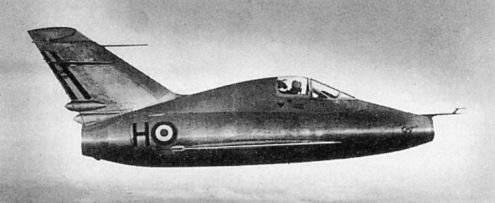
Nord 1402 A/B и 1405 Gerfaut
SFECMAS (ранее Arsenal) 1402A Gerfaut IA представлял собой экспериментальный самолет с треугольным крылом. Позднее SFECMAS вошла в состав "Nord". Gerfaut имел тонкое треугольное крыло со стреловидностью 58°25' по передней кромке, стреловидное вертикальное оперение, на котором был установлен треугольный стабилизатор, и убирающееся шасси. Впервые взлетевший 15 января 1954 года, самолет был оснащен ТРД SNECMA Atar 101C тягой 27,45 кН. 3 августа 1954 года самолет стал первой западноевропейской машиной, преодолевшей скорость звука без использования вспомогательных средств повышения тяги. N 1402B Gerfaut IB, взлетевший 9 февраля 1955 года, имел увеличенное крыло, ТРД Atar 101D1 такой же тяги и ряд доработок. Вариант N 1405 Gerfaut II отличался доработанной конструкцией и, получив ТРД Atar 101F тягой 37,26 кН, совершил первый полет 17 апреля 1956 года. Позднее он летал с ТРД Atar G21 тягой 39,22 кН на форсаже. После завершения испытаний в 1958 году этот самолет использовался для отработки РЛС Aladin, предназначенной для перехватчиков на больших скоростях и высотах.
- Описание
Фотографии
-
Мировая Авиация 205
Gerfaut, скоростной экспериментальный самолет с треугольным крылом, напоминавший британский Fairey Delta, даже в своем первоначальном варианте превзошел скорость звука.
-
Мировая Авиация 21
17 апреля 1956г.: первый перехватчик с дельтовидным крылом SFECMAS Gerfaut II выполнил первый полет на авиабазе Истр, Франция. Gerfaut II представлял собой сугубо экспериментальный самолет, он был способен преодолевать скорость звука без включения форсажа.
-
Air International 1985-07 / M.Spick - The Fighter (2)
Although the ramjet had fewer adherents than the rocket as a means of fighter propulsion, in combination with the turbojet it possessed its proponents in both the USA and France. In the latter, one of the leading protagonists was Jean Galtier who evolved, from the Atar 101 turbojet-powered SFECMAS 1402 Gerfaut I (on photo) the turbo-ramjet Nord 1500 Griffon II. In the event, this somewhat exotic form of fighter propulsion had fallen by the wayside by the early 'sixties.
-
Air Pictorial 1955-04 / Boffin - The heat barrier
On February 11th the SNCAN Gerfaut IB exceeded the speed of sound in level flight using the normal power of its SNECMA Atar turbojet. The remarkable feature of this flight was that the aeroplane was fitted with a new wing of considerably increased area. The new wing gives a stalling speed comparable with that of contemporary single-seater fighters, and despite the extra weIght and drag the rate of climb of this aeroplane remains phenomenal. A brake 'chute is still used for landing. The Gerfaut's excellent performance (on 6,160 lb. of thrust) brings it a step nearer to the threshold of a new "barrier" - and one that is considerably more difficult to vanquish than the sound barrier.
-
Мировая Авиация 137
Nord 1402 Gerfaut. Самолет N.1042 взлетел 15 января 1954 года. Сначала летал пилотируемый планер Nord 1301, показавший пилотажные характеристики на низких скоростях своего дельтовидного крыла с углом стреловидности 60°. Самолет Gerfaut имел крыло низкой относительной толщины, позволявшее летать на сверхзвуке. 3 августа 1954 года он под управлением Андре Турка превысил скорость 1,0 Маха в горизонтальном полете. На самолете N.1402B Gerfaut IB (фото) летали пилоты Турка и Мишель Шалар. Этот аппарат с более мощным форсажным турбореактивным двигателем Atar G установил пять рекордов скороподъемности, включая набор высоты 15 000 м за 3 минуты 36 секунд.
The rather ugly, corpulent appearance of the S.F.E.C.M.A.S. 1405.02 Gerfaut II belied the machine's impressive performance. Developed from the Gerfaut, first flown on 15 January 1954, the Gerfaut lIs less than beauteous exterior was dictated by 'Area Ruling' a newly introduced means of minimising transonic drag rise. Devised by NACA aerodynamicist, Richard Whitcombe, 'Area Ruling' involved shaping the contours of an aircraft so that its overall cross-section rose and faded smoothly to zero along the machine's length. Also known as 'waisting', as on the Grumman F11F-1 and Blackburn Buccaneer, 'Area Ruling' sometimes required bulges to be added. A halfway point along the line of Arsenal-devised wooden construction delta-winged gliders and Nord's impressive Griffon II, the Gerfaut was to become Europe's first aircraft to exceed Mach I without recourse to rocket boosting. Power for the Gerfaut was provided by a 6.170lb s.t. S.N.E.C.M.A. Atar 101C turbojet with reheat, the engine being mounted in one long air duct uninterrupted by cockpit and fuel tanks, etc., all of which are housed above. Aided by its area ruling, the Gerfaut could reach Mach 1.3 at 36.000 feet, or 859mph. -
Air Pictorial 1955-08 / J.Stevens - "Farnborough" in Europe
First photograph of a model of the nearly-completed Gerfaut II.
-
Air Pictorial 1956-12
NORD 1405 GERFAUT II. Essentially a research delta the single-seat Nord 1405 Gerfaut II (Gerfalcon or Northern Falcon) has much in common with the Nord 1500 Griffon which was described in the April issue of Air Pictorial. They are complementary to one another, being designed to perfect the "one-shot" bomber interception theme. As evidence of the attempt to "get upstairs" quickly a recent unconfirmed report states that the Gerfaut II prototype reached 36,500 ft. from a standing start in 3 min. 2 sec. Designed by Jean Galtier, the Nord 1405 Gerfaut II is the progressive development of the Nord-SFECMAS 1402A Gerfaut IA which new for the first time on 15th January 1954. The Gerfaut lA became the first European jet aircraft to exceed Mach 1.0 in level flight on 3rd August of the same year. In its current form the Gerfaut II has been developed from the Nord 1402B Gerfaut IB. The present external shape differs particularly in respect of the wing plan form and the tailplane ; the former having blunt tips, and the latter likewise bul with the leading edge now extending to the fin leading edge. Also noticeable are the reheat vanes extending beyond the tail cone .
- Фотографии






